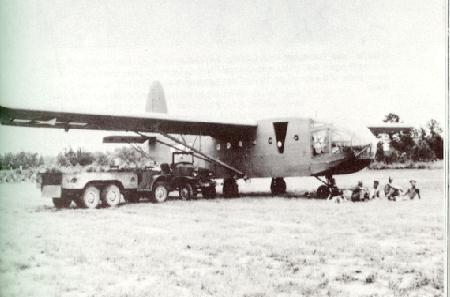As is my habit, I was using an old National Geographic (Aug. 1944) to research a build, in this case an article on the First Air Commandos in Burma, with some great photos of B-25Gs and A-36’s, all with their trademark white diagonal stripes along the fuselage. I kept reading and came across an article on gliders and there are photos of CG-4s and American Horsas. Then there were a couple of pages showing operations with the CG-13, which has a profile that looks like a sort of simplified C-123. I know that the 123’s design originated with a glider, but I know little about that genre other than the Wacos. I’ve never seen this CG-13A and wonder if it is the grandfather of the medium transport of Vietnam fame. I know the Waco and Horsa kits from Italeri/Testor. Not bad, really. But has this other glider been kitted by anyone?
And, as I’ve said before, if you have access to a decent public library or college library, or if you go to flea markets, look up your builds in National Geographic. They covered everything with wings from the Wright Bros. to mid-60s jets, when the space program overcame Nat. Geographic’s fascination with airplanes. I was lucky enough to get my hands on a bunch of WW II issues and they are invaluable for accurate info gleened from photos.
You’re correct, the Chase CG-13 is the direct ancestor of the C-123. I believe the 123’s direct father was the larger post war development of the CG-13, the CG-20. Fairchild absorbed Chase in the late forties, so it became the Fairchild C-123. Apparently, someone saw or knew about the Germans modifing one of their gliders by the installation of a couple of engines (Gotha Go242/244 ???). So a couple of R-2800s on the thing and the rest is history.
Just as interesting to me was the modification of a C-47 into a cargo glider. They removed both every thing forward of each fire wall (engines, props, engine mounts and cowling), added hemispheric covers to each firewall and they had a glider. I’ve never read anything to confirm it, but I was told they mounted a hydraulic pump to the port side of the fuselage to allow the landing gear and flaps to be operated with having to hand pump them up and down. The only pictures of it under tow it had the landing gear retracted. With the same load as a loaded C-47 (less fuel of course), it towed very easily and its glide ratio was much better than the Waco or the Hadrian. I read that they were looking for a glider that could carry more than any gliders then in the inventory and could be developed rapidly for the invasion of Japan. The war ended and the glider (think it was either CG-17 or CG-19, can’t remember which) was not needed, so they turned it back into a C-47.
Back in the late 60s, early 70s, the British periodical Air Enthusiast ran a series (one a month) on each country which had operated military gliders, listing all the gliders the country had operated, how each glider was developed and its use up through its last version and the factors which caused the cessation of the use of gliders for warfare. Lots of pictures and three views (small but usable). I remember haveing the magazines with articles for the US, Britain, Germany, Russia, and Japan. Be pretty tough to find them now though.
I always understood that the helicopter and it’s terrible operating history put an end to the glider’s short lifetime in combat. Is there another reason? Those guys who wore the wings with the letter “G” in the middle were right: It stood for “Guts.”
Here is a pic I found on the web

and another
